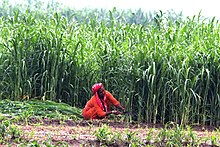
Back Pastura AN علف Arabic ܟܣܬܐ ARC Q'achu AY Yem AZ Мал аҙығы BA Корм BE Фураж Bulgarian পশুখাদ্য Bengali/Bangla Farratge Catalan
This article needs additional citations for verification. (October 2014) |

Fodder (/ˈfɒdər/), also called provender (/ˈprɒvəndər/), is any agricultural foodstuff used specifically to feed domesticated livestock, such as cattle, rabbits, sheep, horses, chickens and pigs. "Fodder" refers particularly to food given to the animals (including plants cut and carried to them), rather than that which they forage for themselves (called forage). Fodder includes hay, straw, silage, compressed and pelleted feeds, oils and mixed rations, and sprouted grains and legumes (such as bean sprouts, fresh malt, or spent malt). Most animal feed is from plants, but some manufacturers add ingredients to processed feeds that are of animal origin.
The worldwide animal feed trade produced 1.245 billion tons of compound feed in 2022 according to an estimate by the International Feed Industry Federation,[1] with an annual growth rate of about 2%. The use of agricultural land to grow feed rather than human food can be controversial (see food vs. feed); some types of feed, such as corn (maize), can also serve as human food; those that cannot, such as grassland grass, may be grown on land that can be used for crops consumed by humans. In many cases the production of grass for cattle fodder is a valuable intercrop between crops for human consumption, because it builds the organic matter in the soil.[citation needed] When evaluating if this soil organic matter increase mitigates climate change, both permanency of the added organic matter as well as emissions produced during use of the fodder product have to be taken into account.[clarification needed] Some agricultural byproducts fed to animals may be considered unsavory by humans.[citation needed]

- ^ "Global Feed Statistics". International Feed Industry Federation. Retrieved 18 March 2024.